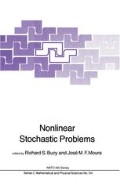Abstract
In this paper, we demonstrate the usefulness of the maximum- entropy method in analysing the spectral (Doppler) content of clutter as encountered in a radar surveillance environment. Experimental results (based on recorded radar data) are included which show that it is indeed possible to extract Doppler-based features for deciding whether the clutter is due to reflections from the ground, weather disturbances, or migrating flocks of birds. In this way, it becomes possible to vector an aircraft around a hazardous (turbulent) area, and thereby avoid the possibility of danger to the safety of the aircraft.
Access this chapter
Tax calculation will be finalised at checkout
Purchases are for personal use only
Preview
Unable to display preview. Download preview PDF.
References
IEEE Standard Dictionary of Electrical and Electronic Terms, John Wiley & Sons, Inc., 1972.
S. Haykin, B.W. Currie, C. Gibson and S. Kesler, “Date- Adaptive Doppler Processing of Radar Signals”, in preparation.
J. P. Burg, “Maximum Entropy Spectral Analysis”, Ph.D. Dissertation, Stanford University, Stanford, CA., May 1975.
M.I. Skolnik, “Radar Handbook”, McGraw-Hill Book Company, New York, N.Y., 1970.
D. Atlas, “Advances in Radar Meteorology”, in H.E. Landsberg and J. van Mieghen (eds.): “Advances in Geophysics”, vol. 10, pp. 318 - 468, Academic Press, Inc., New York, N.Y., 1964.
S. Haykin and S. Kesler, “Prediction Error Filtering and Maximum Entropy Spectral Estimation”, Chapter 2 in S. Haykin (Editor): “Nonlinear Methods of Spectral Analysis”, Springer, Berlin, 1979.
B.W. Currie and S. Haykin, “Radar Clutter Classifier Prototype for Use with the TRACS Airport Surveillance Radar”, Proc. 1st North American Birdstrike Prevention Workshop, pp. 6.1-6.30, Ottawa, Ontario, 17 - 18 Sept. 1981.
Author information
Authors and Affiliations
Editor information
Editors and Affiliations
Rights and permissions
Copyright information
© 1983 D. Reidel Publishing Company
About this chapter
Cite this chapter
Haykin, S. (1983). Classification of Radar Clutter using the Maximum-Entropy Method. In: Bucy, R.S., Moura, J.M.F. (eds) Nonlinear Stochastic Problems. NATO ASI Series, vol 104. Springer, Dordrecht. https://doi.org/10.1007/978-94-009-7142-4_4
Download citation
DOI: https://doi.org/10.1007/978-94-009-7142-4_4
Publisher Name: Springer, Dordrecht
Print ISBN: 978-94-009-7144-8
Online ISBN: 978-94-009-7142-4
eBook Packages: Springer Book Archive

